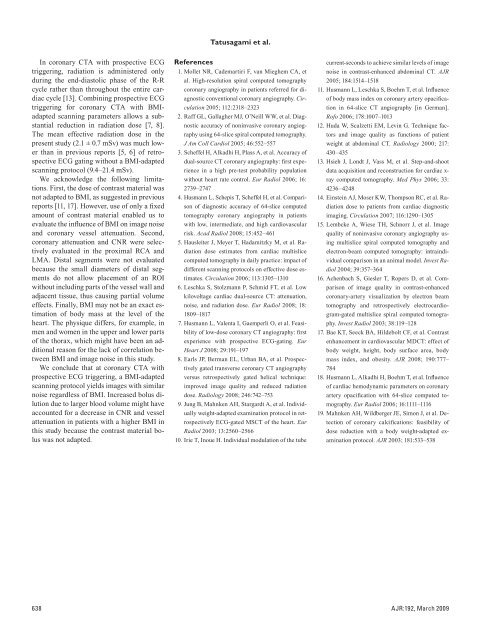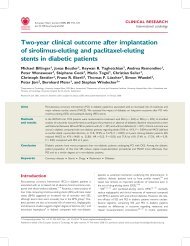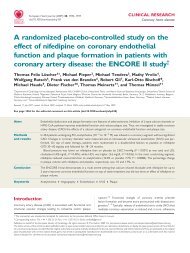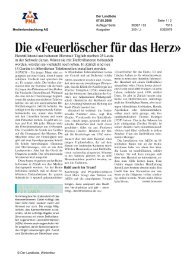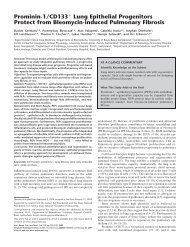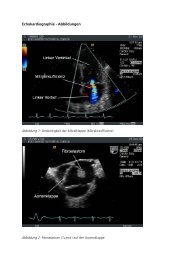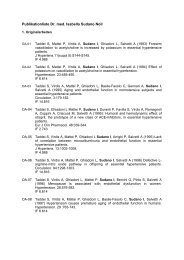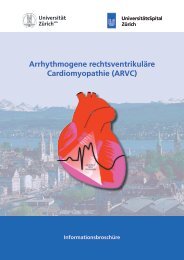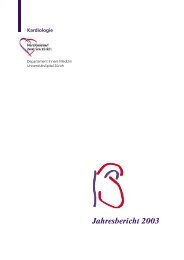PDF (508 KB)
PDF (508 KB)
PDF (508 KB)
You also want an ePaper? Increase the reach of your titles
YUMPU automatically turns print PDFs into web optimized ePapers that Google loves.
Tatusagami et al.<br />
In coronary CTA with prospective ECG<br />
triggering, radiation is administered only<br />
during the end-diastolic phase of the R-R<br />
cycle rather than throughout the entire cardiac<br />
cycle [13]. Combining prospective ECG<br />
triggering for coronary CTA with BMIadapted<br />
scanning parameters allows a substantial<br />
reduction in radiation dose [7, 8].<br />
The mean effective radiation dose in the<br />
present study (2.1 ± 0.7 mSv) was much lower<br />
than in previous reports [5, 6] of retrospective<br />
ECG gating without a BMI-adapted<br />
scanning protocol (9.4–21.4 mSv).<br />
We acknowledge the following limitations.<br />
First, the dose of contrast material was<br />
not adapted to BMI, as suggested in previous<br />
reports [11, 17]. However, use of only a fixed<br />
amount of contrast material enabled us to<br />
evaluate the influence of BMI on image noise<br />
and coronary vessel attenuation. Second,<br />
coronary attenuation and CNR were selectively<br />
evaluated in the proximal RCA and<br />
LMA. Distal segments were not evaluated<br />
because the small diameters of distal segments<br />
do not allow placement of an ROI<br />
without including parts of the vessel wall and<br />
adjacent tissue, thus causing partial volume<br />
effects. Finally, BMI may not be an exact estimation<br />
of body mass at the level of the<br />
heart. The physique differs, for example, in<br />
men and women in the upper and lower parts<br />
of the thorax, which might have been an additional<br />
reason for the lack of correlation between<br />
BMI and image noise in this study.<br />
We conclude that at coronary CTA with<br />
prospective ECG triggering, a BMI-adapted<br />
scanning protocol yields images with similar<br />
noise regardless of BMI. Increased bolus dilution<br />
due to larger blood volume might have<br />
accounted for a decrease in CNR and vessel<br />
attenuation in patients with a higher BMI in<br />
this study because the contrast material bolus<br />
was not adapted.<br />
References<br />
1. Mollet NR, Cademartiri F, van Mieghem CA, et<br />
al. High-resolution spiral computed tomography<br />
coronary angiography in patients referred for diagnostic<br />
conventional coronary angiography. Circulation<br />
2005; 112:2318–2323<br />
2. Raff GL, Gallagher MJ, O’Neill WW, et al. Diagnostic<br />
accuracy of noninvasive coronary angiography<br />
using 64-slice spiral computed tomography.<br />
J Am Coll Cardiol 2005; 46:552–557<br />
3. Scheffel H, Alkadhi H, Plass A, et al. Accuracy of<br />
dual-source CT coronary angiography: first experience<br />
in a high pre-test probability population<br />
without heart rate control. Eur Radiol 2006; 16:<br />
2739–2747<br />
4. Husmann L, Schepis T, Scheffel H, et al. Comparison<br />
of diagnostic accuracy of 64-slice computed<br />
tomography coronary angiography in patients<br />
with low, intermediate, and high cardio vascular<br />
risk. Acad Radiol 2008; 15:452–461<br />
5. Hausleiter J, Meyer T, Hadamitzky M, et al. Radiation<br />
dose estimates from cardiac multislice<br />
computed tomography in daily practice: impact of<br />
different scanning protocols on effective dose estimates.<br />
Circulation 2006; 113:1305–1310<br />
6. Leschka S, Stolzmann P, Schmid FT, et al. Low<br />
kilovoltage cardiac dual-source CT: attenuation,<br />
noise, and radiation dose. Eur Radiol 2008; 18:<br />
1809–1817<br />
7. Husmann L, Valenta I, Gaemperli O, et al. Feasibility<br />
of low-dose coronary CT angiography: first<br />
experience with prospective ECG-gating. Eur<br />
Heart J 2008; 29:191–197<br />
8. Earls JP, Berman EL, Urban BA, et al. Prospectively<br />
gated transverse coronary CT angiography<br />
versus retrospectively gated helical technique:<br />
improved image quality and reduced radiation<br />
dose. Radiology 2008; 246:742–753<br />
9. Jung B, Mahnken AH, Stargardt A, et al. Individually<br />
weight-adapted examination protocol in retrospectively<br />
ECG-gated MSCT of the heart. Eur<br />
Radiol 2003; 13:2560–2566<br />
10. Irie T, Inoue H. Individual modulation of the tube<br />
current-seconds to achieve similar levels of image<br />
noise in contrast-enhanced abdominal CT. AJR<br />
2005; 184:1514–1518<br />
11. Husmann L, Leschka S, Boehm T, et al. Influence<br />
of body mass index on coronary artery opacification<br />
in 64-slice CT angiography [in German].<br />
Rofo 2006; 178:1007–1013<br />
12. Huda W, Scalzetti EM, Levin G. Technique factors<br />
and image quality as functions of patient<br />
weight at abdominal CT. Radiology 2000; 217:<br />
430–435<br />
13. Hsieh J, Londt J, Vass M, et al. Step-and-shoot<br />
data acquisition and reconstruction for cardiac x-<br />
ray computed tomography. Med Phys 2006; 33:<br />
4236–4248<br />
14. Einstein AJ, Moser KW, Thompson RC, et al. Radiation<br />
dose to patients from cardiac diagnostic<br />
imaging. Circulation 2007; 116:1290–1305<br />
15. Lembcke A, Wiese TH, Schnorr J, et al. Image<br />
quality of noninvasive coronary angiography using<br />
multislice spiral computed tomography and<br />
electron-beam computed tomography: intraindividual<br />
comparison in an animal model. Invest Radiol<br />
2004; 39:357–364<br />
16. Achenbach S, Giesler T, Ropers D, et al. Comparison<br />
of image quality in contrast-enhanced<br />
coronary-artery visualization by electron beam<br />
tomography and retrospectively electrocardiogram-gated<br />
multislice spiral computed tomography.<br />
Invest Radiol 2003; 38:119–128<br />
17. Bae KT, Seeck BA, Hildebolt CF, et al. Contrast<br />
enhancement in cardiovascular MDCT: effect of<br />
body weight, height, body surface area, body<br />
mass index, and obesity. AJR 2008; 190:777–<br />
784<br />
18. Husmann L, Alkadhi H, Boehm T, et al. Influence<br />
of cardiac hemodynamic parameters on coronary<br />
artery opacification with 64-slice computed tomography.<br />
Eur Radiol 2006; 16:1111–1116<br />
19. Mahnken AH, Wildberger JE, Simon J, et al. Detection<br />
of coronary calcifications: feasibility of<br />
dose reduction with a body weight-adapted examination<br />
protocol. AJR 2003; 181:533–538<br />
638 AJR:192, March 2009


